International Business Strategy Report: Grange Shiraz in the UK Market
VerifiedAdded on 2023/06/07
|23
|5527
|168
Report
AI Summary
This report details the international business strategy for Grange Shiraz, a wine from Treasury Wine Estates, targeting the UK market. It begins with an executive summary highlighting the UK wine industry's growth, the target demographic (24-45 year olds), and the intended distribution channels. The report then delves into industry and market analyses, including Porter's Five Forces and competitor analysis, followed by a SWOT analysis to assess the brand's strengths and weaknesses. The international strategy section discusses the global strategy approach, the application of Dunning's Eclectic paradigm for market entry mode selection (direct exporting), and the organizational structure. The report also covers international human resource considerations and the marketing mix employed. The report concludes with a discussion on the future of the business, aiming for a 3% market share by the end of 2023. The appendices includes tables and competitor analysis.
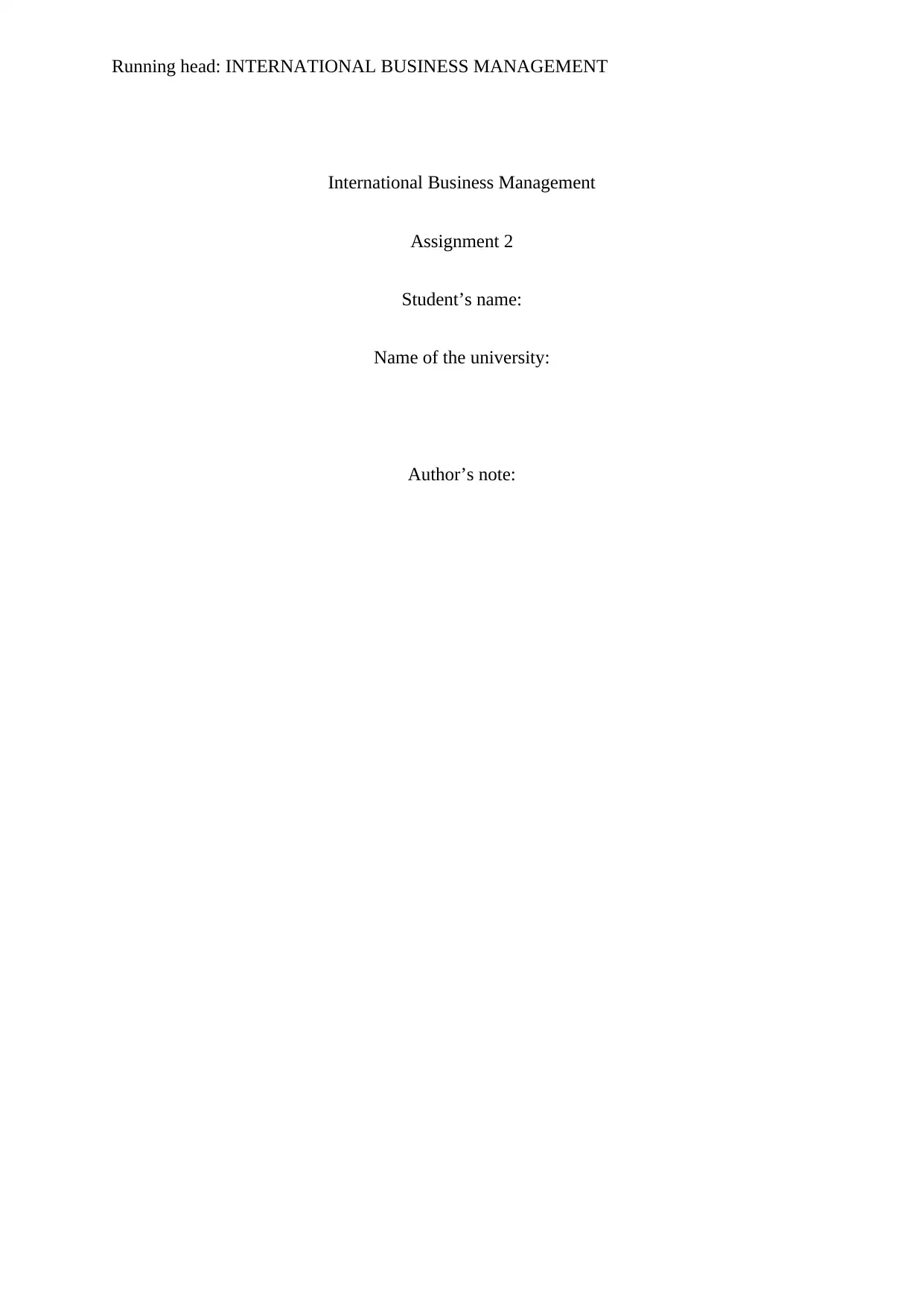
Running head: INTERNATIONAL BUSINESS MANAGEMENT
International Business Management
Assignment 2
Student’s name:
Name of the university:
Author’s note:
International Business Management
Assignment 2
Student’s name:
Name of the university:
Author’s note:
Paraphrase This Document
Need a fresh take? Get an instant paraphrase of this document with our AI Paraphraser
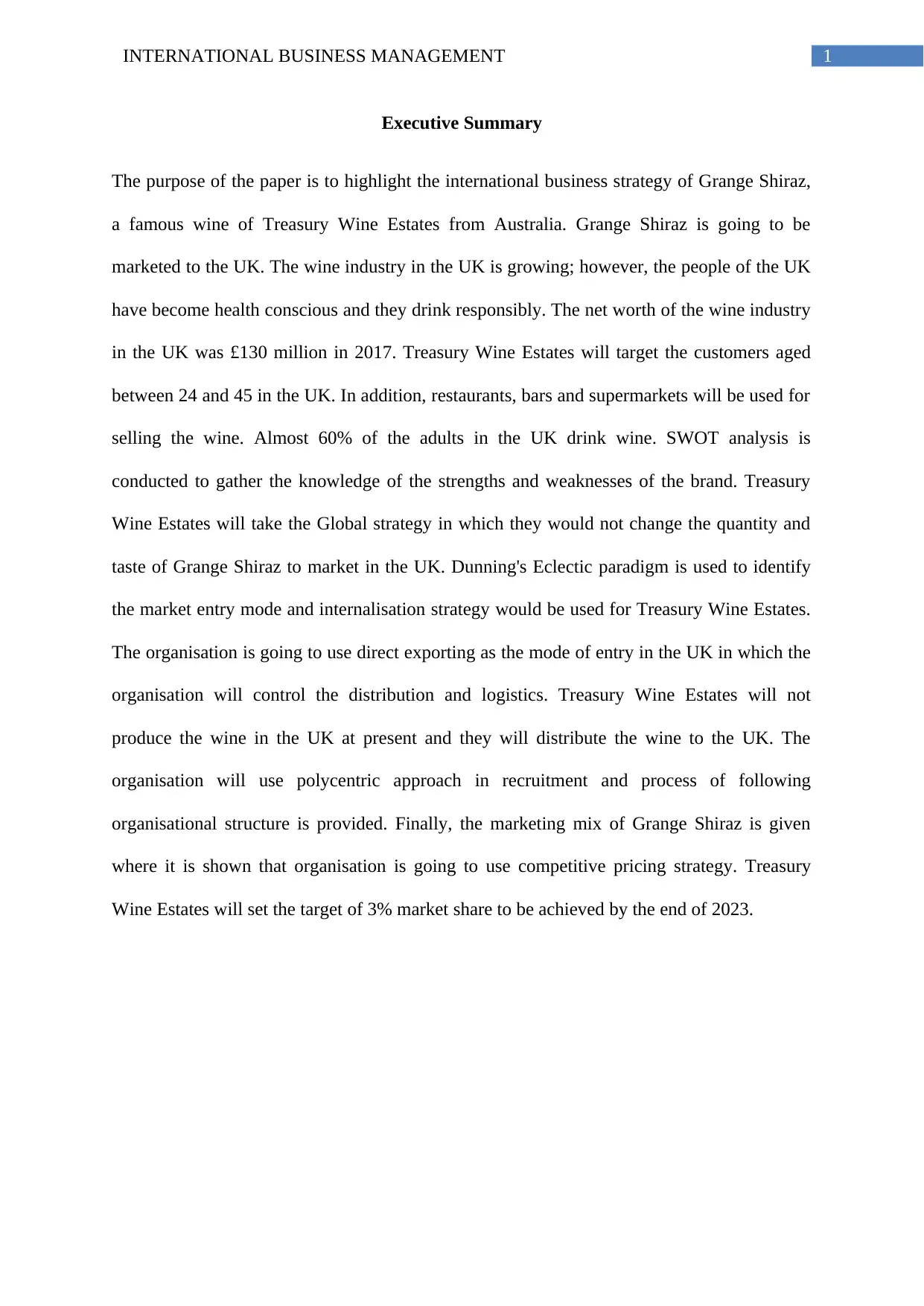
1INTERNATIONAL BUSINESS MANAGEMENT
Executive Summary
The purpose of the paper is to highlight the international business strategy of Grange Shiraz,
a famous wine of Treasury Wine Estates from Australia. Grange Shiraz is going to be
marketed to the UK. The wine industry in the UK is growing; however, the people of the UK
have become health conscious and they drink responsibly. The net worth of the wine industry
in the UK was £130 million in 2017. Treasury Wine Estates will target the customers aged
between 24 and 45 in the UK. In addition, restaurants, bars and supermarkets will be used for
selling the wine. Almost 60% of the adults in the UK drink wine. SWOT analysis is
conducted to gather the knowledge of the strengths and weaknesses of the brand. Treasury
Wine Estates will take the Global strategy in which they would not change the quantity and
taste of Grange Shiraz to market in the UK. Dunning's Eclectic paradigm is used to identify
the market entry mode and internalisation strategy would be used for Treasury Wine Estates.
The organisation is going to use direct exporting as the mode of entry in the UK in which the
organisation will control the distribution and logistics. Treasury Wine Estates will not
produce the wine in the UK at present and they will distribute the wine to the UK. The
organisation will use polycentric approach in recruitment and process of following
organisational structure is provided. Finally, the marketing mix of Grange Shiraz is given
where it is shown that organisation is going to use competitive pricing strategy. Treasury
Wine Estates will set the target of 3% market share to be achieved by the end of 2023.
Executive Summary
The purpose of the paper is to highlight the international business strategy of Grange Shiraz,
a famous wine of Treasury Wine Estates from Australia. Grange Shiraz is going to be
marketed to the UK. The wine industry in the UK is growing; however, the people of the UK
have become health conscious and they drink responsibly. The net worth of the wine industry
in the UK was £130 million in 2017. Treasury Wine Estates will target the customers aged
between 24 and 45 in the UK. In addition, restaurants, bars and supermarkets will be used for
selling the wine. Almost 60% of the adults in the UK drink wine. SWOT analysis is
conducted to gather the knowledge of the strengths and weaknesses of the brand. Treasury
Wine Estates will take the Global strategy in which they would not change the quantity and
taste of Grange Shiraz to market in the UK. Dunning's Eclectic paradigm is used to identify
the market entry mode and internalisation strategy would be used for Treasury Wine Estates.
The organisation is going to use direct exporting as the mode of entry in the UK in which the
organisation will control the distribution and logistics. Treasury Wine Estates will not
produce the wine in the UK at present and they will distribute the wine to the UK. The
organisation will use polycentric approach in recruitment and process of following
organisational structure is provided. Finally, the marketing mix of Grange Shiraz is given
where it is shown that organisation is going to use competitive pricing strategy. Treasury
Wine Estates will set the target of 3% market share to be achieved by the end of 2023.
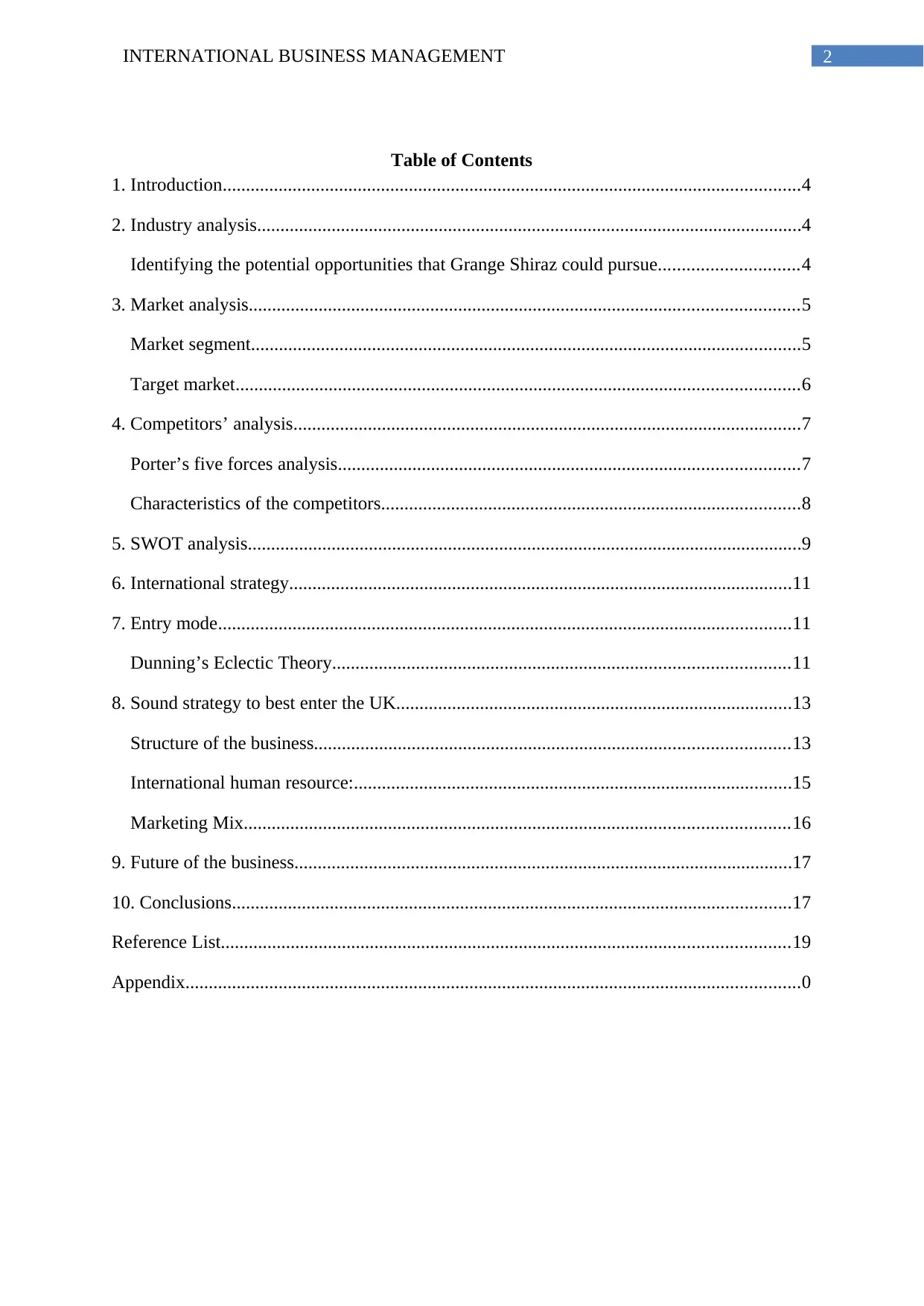
2INTERNATIONAL BUSINESS MANAGEMENT
Table of Contents
1. Introduction............................................................................................................................4
2. Industry analysis.....................................................................................................................4
Identifying the potential opportunities that Grange Shiraz could pursue..............................4
3. Market analysis......................................................................................................................5
Market segment......................................................................................................................5
Target market.........................................................................................................................6
4. Competitors’ analysis.............................................................................................................7
Porter’s five forces analysis...................................................................................................7
Characteristics of the competitors..........................................................................................8
5. SWOT analysis.......................................................................................................................9
6. International strategy............................................................................................................11
7. Entry mode...........................................................................................................................11
Dunning’s Eclectic Theory..................................................................................................11
8. Sound strategy to best enter the UK.....................................................................................13
Structure of the business......................................................................................................13
International human resource:..............................................................................................15
Marketing Mix.....................................................................................................................16
9. Future of the business...........................................................................................................17
10. Conclusions........................................................................................................................17
Reference List..........................................................................................................................19
Appendix....................................................................................................................................0
Table of Contents
1. Introduction............................................................................................................................4
2. Industry analysis.....................................................................................................................4
Identifying the potential opportunities that Grange Shiraz could pursue..............................4
3. Market analysis......................................................................................................................5
Market segment......................................................................................................................5
Target market.........................................................................................................................6
4. Competitors’ analysis.............................................................................................................7
Porter’s five forces analysis...................................................................................................7
Characteristics of the competitors..........................................................................................8
5. SWOT analysis.......................................................................................................................9
6. International strategy............................................................................................................11
7. Entry mode...........................................................................................................................11
Dunning’s Eclectic Theory..................................................................................................11
8. Sound strategy to best enter the UK.....................................................................................13
Structure of the business......................................................................................................13
International human resource:..............................................................................................15
Marketing Mix.....................................................................................................................16
9. Future of the business...........................................................................................................17
10. Conclusions........................................................................................................................17
Reference List..........................................................................................................................19
Appendix....................................................................................................................................0
⊘ This is a preview!⊘
Do you want full access?
Subscribe today to unlock all pages.

Trusted by 1+ million students worldwide

3INTERNATIONAL BUSINESS MANAGEMENT
Paraphrase This Document
Need a fresh take? Get an instant paraphrase of this document with our AI Paraphraser
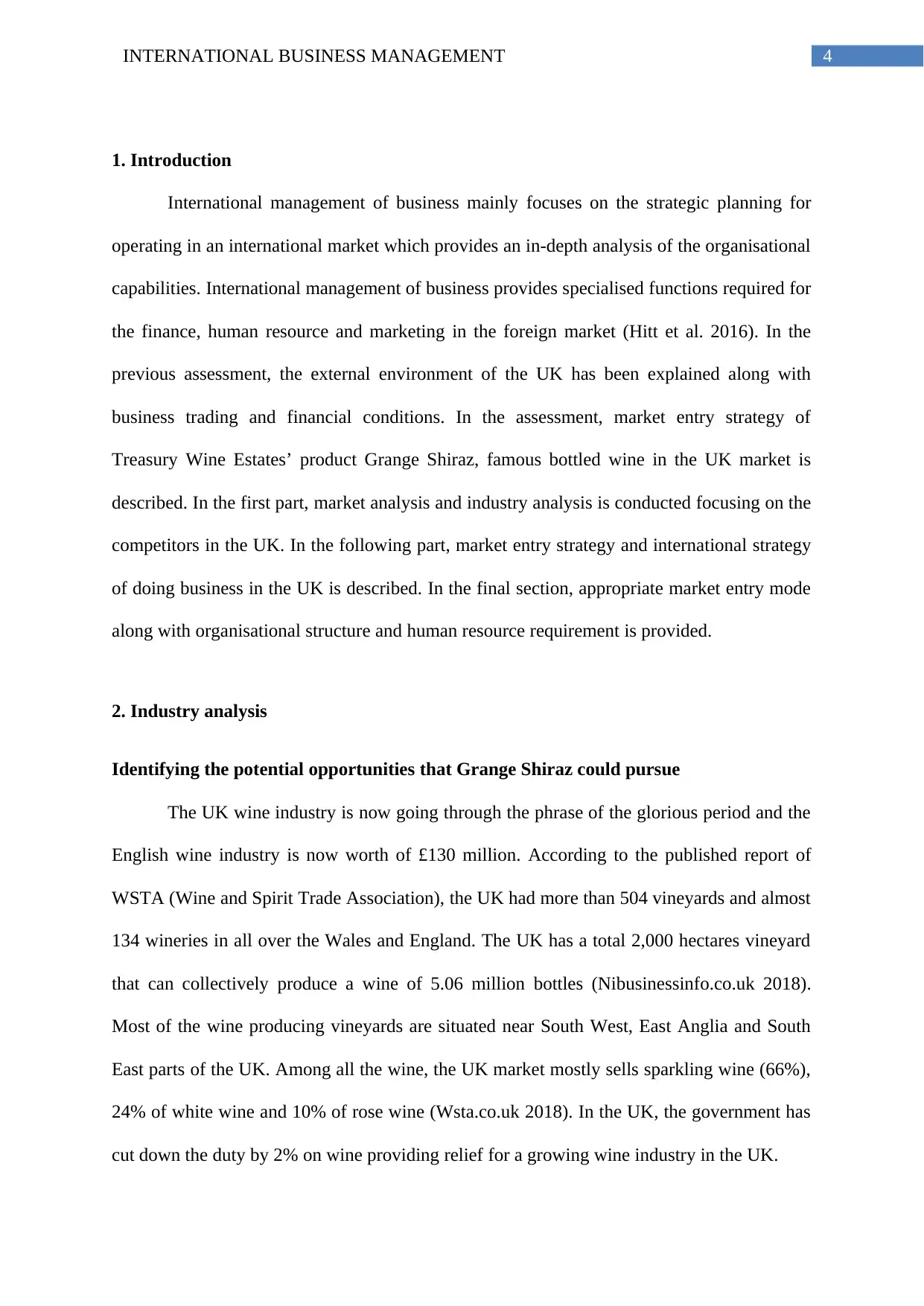
4INTERNATIONAL BUSINESS MANAGEMENT
1. Introduction
International management of business mainly focuses on the strategic planning for
operating in an international market which provides an in-depth analysis of the organisational
capabilities. International management of business provides specialised functions required for
the finance, human resource and marketing in the foreign market (Hitt et al. 2016). In the
previous assessment, the external environment of the UK has been explained along with
business trading and financial conditions. In the assessment, market entry strategy of
Treasury Wine Estates’ product Grange Shiraz, famous bottled wine in the UK market is
described. In the first part, market analysis and industry analysis is conducted focusing on the
competitors in the UK. In the following part, market entry strategy and international strategy
of doing business in the UK is described. In the final section, appropriate market entry mode
along with organisational structure and human resource requirement is provided.
2. Industry analysis
Identifying the potential opportunities that Grange Shiraz could pursue
The UK wine industry is now going through the phrase of the glorious period and the
English wine industry is now worth of £130 million. According to the published report of
WSTA (Wine and Spirit Trade Association), the UK had more than 504 vineyards and almost
134 wineries in all over the Wales and England. The UK has a total 2,000 hectares vineyard
that can collectively produce a wine of 5.06 million bottles (Nibusinessinfo.co.uk 2018).
Most of the wine producing vineyards are situated near South West, East Anglia and South
East parts of the UK. Among all the wine, the UK market mostly sells sparkling wine (66%),
24% of white wine and 10% of rose wine (Wsta.co.uk 2018). In the UK, the government has
cut down the duty by 2% on wine providing relief for a growing wine industry in the UK.
1. Introduction
International management of business mainly focuses on the strategic planning for
operating in an international market which provides an in-depth analysis of the organisational
capabilities. International management of business provides specialised functions required for
the finance, human resource and marketing in the foreign market (Hitt et al. 2016). In the
previous assessment, the external environment of the UK has been explained along with
business trading and financial conditions. In the assessment, market entry strategy of
Treasury Wine Estates’ product Grange Shiraz, famous bottled wine in the UK market is
described. In the first part, market analysis and industry analysis is conducted focusing on the
competitors in the UK. In the following part, market entry strategy and international strategy
of doing business in the UK is described. In the final section, appropriate market entry mode
along with organisational structure and human resource requirement is provided.
2. Industry analysis
Identifying the potential opportunities that Grange Shiraz could pursue
The UK wine industry is now going through the phrase of the glorious period and the
English wine industry is now worth of £130 million. According to the published report of
WSTA (Wine and Spirit Trade Association), the UK had more than 504 vineyards and almost
134 wineries in all over the Wales and England. The UK has a total 2,000 hectares vineyard
that can collectively produce a wine of 5.06 million bottles (Nibusinessinfo.co.uk 2018).
Most of the wine producing vineyards are situated near South West, East Anglia and South
East parts of the UK. Among all the wine, the UK market mostly sells sparkling wine (66%),
24% of white wine and 10% of rose wine (Wsta.co.uk 2018). In the UK, the government has
cut down the duty by 2% on wine providing relief for a growing wine industry in the UK.
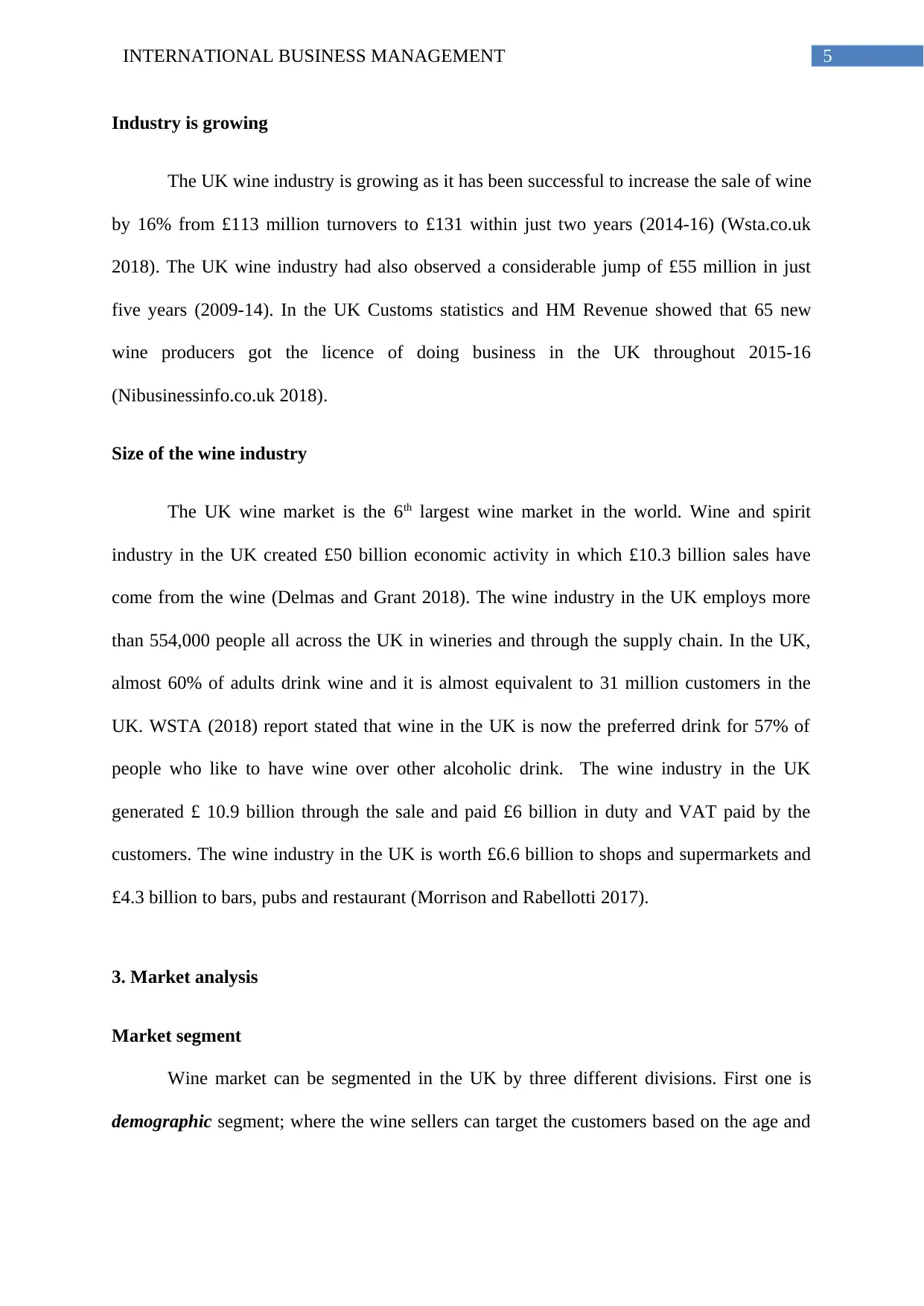
5INTERNATIONAL BUSINESS MANAGEMENT
Industry is growing
The UK wine industry is growing as it has been successful to increase the sale of wine
by 16% from £113 million turnovers to £131 within just two years (2014-16) (Wsta.co.uk
2018). The UK wine industry had also observed a considerable jump of £55 million in just
five years (2009-14). In the UK Customs statistics and HM Revenue showed that 65 new
wine producers got the licence of doing business in the UK throughout 2015-16
(Nibusinessinfo.co.uk 2018).
Size of the wine industry
The UK wine market is the 6th largest wine market in the world. Wine and spirit
industry in the UK created £50 billion economic activity in which £10.3 billion sales have
come from the wine (Delmas and Grant 2018). The wine industry in the UK employs more
than 554,000 people all across the UK in wineries and through the supply chain. In the UK,
almost 60% of adults drink wine and it is almost equivalent to 31 million customers in the
UK. WSTA (2018) report stated that wine in the UK is now the preferred drink for 57% of
people who like to have wine over other alcoholic drink. The wine industry in the UK
generated £ 10.9 billion through the sale and paid £6 billion in duty and VAT paid by the
customers. The wine industry in the UK is worth £6.6 billion to shops and supermarkets and
£4.3 billion to bars, pubs and restaurant (Morrison and Rabellotti 2017).
3. Market analysis
Market segment
Wine market can be segmented in the UK by three different divisions. First one is
demographic segment; where the wine sellers can target the customers based on the age and
Industry is growing
The UK wine industry is growing as it has been successful to increase the sale of wine
by 16% from £113 million turnovers to £131 within just two years (2014-16) (Wsta.co.uk
2018). The UK wine industry had also observed a considerable jump of £55 million in just
five years (2009-14). In the UK Customs statistics and HM Revenue showed that 65 new
wine producers got the licence of doing business in the UK throughout 2015-16
(Nibusinessinfo.co.uk 2018).
Size of the wine industry
The UK wine market is the 6th largest wine market in the world. Wine and spirit
industry in the UK created £50 billion economic activity in which £10.3 billion sales have
come from the wine (Delmas and Grant 2018). The wine industry in the UK employs more
than 554,000 people all across the UK in wineries and through the supply chain. In the UK,
almost 60% of adults drink wine and it is almost equivalent to 31 million customers in the
UK. WSTA (2018) report stated that wine in the UK is now the preferred drink for 57% of
people who like to have wine over other alcoholic drink. The wine industry in the UK
generated £ 10.9 billion through the sale and paid £6 billion in duty and VAT paid by the
customers. The wine industry in the UK is worth £6.6 billion to shops and supermarkets and
£4.3 billion to bars, pubs and restaurant (Morrison and Rabellotti 2017).
3. Market analysis
Market segment
Wine market can be segmented in the UK by three different divisions. First one is
demographic segment; where the wine sellers can target the customers based on the age and
⊘ This is a preview!⊘
Do you want full access?
Subscribe today to unlock all pages.

Trusted by 1+ million students worldwide
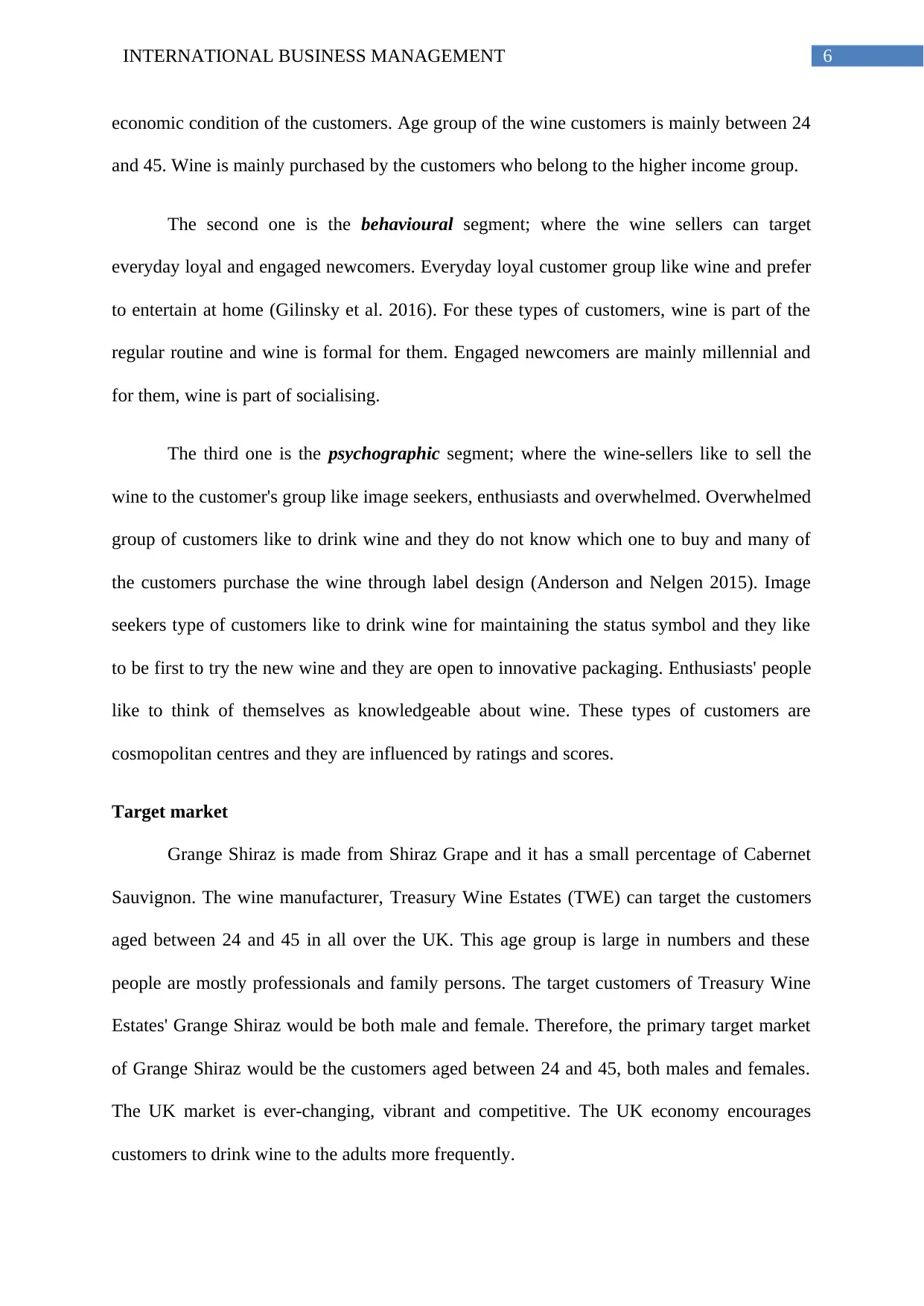
6INTERNATIONAL BUSINESS MANAGEMENT
economic condition of the customers. Age group of the wine customers is mainly between 24
and 45. Wine is mainly purchased by the customers who belong to the higher income group.
The second one is the behavioural segment; where the wine sellers can target
everyday loyal and engaged newcomers. Everyday loyal customer group like wine and prefer
to entertain at home (Gilinsky et al. 2016). For these types of customers, wine is part of the
regular routine and wine is formal for them. Engaged newcomers are mainly millennial and
for them, wine is part of socialising.
The third one is the psychographic segment; where the wine-sellers like to sell the
wine to the customer's group like image seekers, enthusiasts and overwhelmed. Overwhelmed
group of customers like to drink wine and they do not know which one to buy and many of
the customers purchase the wine through label design (Anderson and Nelgen 2015). Image
seekers type of customers like to drink wine for maintaining the status symbol and they like
to be first to try the new wine and they are open to innovative packaging. Enthusiasts' people
like to think of themselves as knowledgeable about wine. These types of customers are
cosmopolitan centres and they are influenced by ratings and scores.
Target market
Grange Shiraz is made from Shiraz Grape and it has a small percentage of Cabernet
Sauvignon. The wine manufacturer, Treasury Wine Estates (TWE) can target the customers
aged between 24 and 45 in all over the UK. This age group is large in numbers and these
people are mostly professionals and family persons. The target customers of Treasury Wine
Estates' Grange Shiraz would be both male and female. Therefore, the primary target market
of Grange Shiraz would be the customers aged between 24 and 45, both males and females.
The UK market is ever-changing, vibrant and competitive. The UK economy encourages
customers to drink wine to the adults more frequently.
economic condition of the customers. Age group of the wine customers is mainly between 24
and 45. Wine is mainly purchased by the customers who belong to the higher income group.
The second one is the behavioural segment; where the wine sellers can target
everyday loyal and engaged newcomers. Everyday loyal customer group like wine and prefer
to entertain at home (Gilinsky et al. 2016). For these types of customers, wine is part of the
regular routine and wine is formal for them. Engaged newcomers are mainly millennial and
for them, wine is part of socialising.
The third one is the psychographic segment; where the wine-sellers like to sell the
wine to the customer's group like image seekers, enthusiasts and overwhelmed. Overwhelmed
group of customers like to drink wine and they do not know which one to buy and many of
the customers purchase the wine through label design (Anderson and Nelgen 2015). Image
seekers type of customers like to drink wine for maintaining the status symbol and they like
to be first to try the new wine and they are open to innovative packaging. Enthusiasts' people
like to think of themselves as knowledgeable about wine. These types of customers are
cosmopolitan centres and they are influenced by ratings and scores.
Target market
Grange Shiraz is made from Shiraz Grape and it has a small percentage of Cabernet
Sauvignon. The wine manufacturer, Treasury Wine Estates (TWE) can target the customers
aged between 24 and 45 in all over the UK. This age group is large in numbers and these
people are mostly professionals and family persons. The target customers of Treasury Wine
Estates' Grange Shiraz would be both male and female. Therefore, the primary target market
of Grange Shiraz would be the customers aged between 24 and 45, both males and females.
The UK market is ever-changing, vibrant and competitive. The UK economy encourages
customers to drink wine to the adults more frequently.
Paraphrase This Document
Need a fresh take? Get an instant paraphrase of this document with our AI Paraphraser
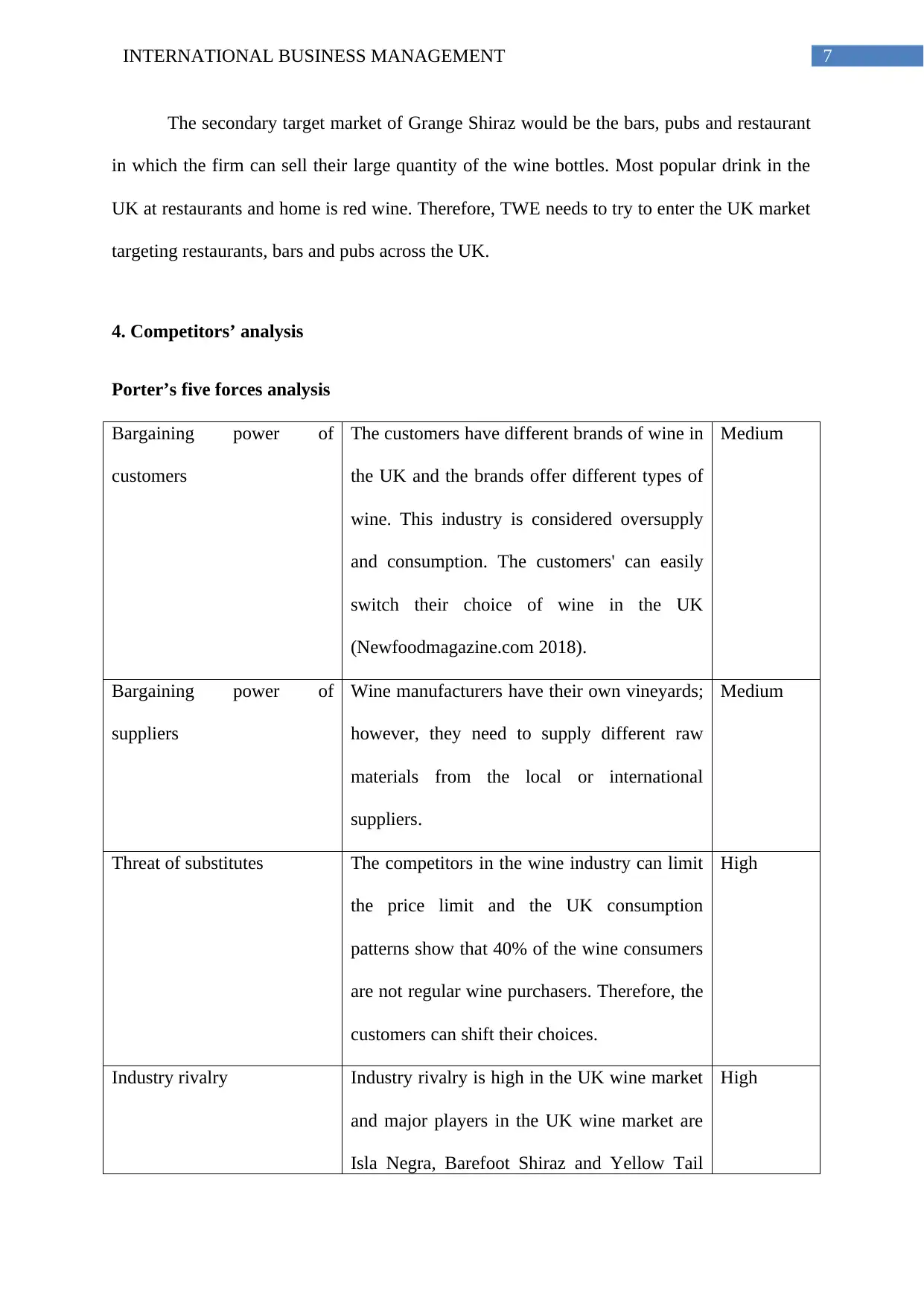
7INTERNATIONAL BUSINESS MANAGEMENT
The secondary target market of Grange Shiraz would be the bars, pubs and restaurant
in which the firm can sell their large quantity of the wine bottles. Most popular drink in the
UK at restaurants and home is red wine. Therefore, TWE needs to try to enter the UK market
targeting restaurants, bars and pubs across the UK.
4. Competitors’ analysis
Porter’s five forces analysis
Bargaining power of
customers
The customers have different brands of wine in
the UK and the brands offer different types of
wine. This industry is considered oversupply
and consumption. The customers' can easily
switch their choice of wine in the UK
(Newfoodmagazine.com 2018).
Medium
Bargaining power of
suppliers
Wine manufacturers have their own vineyards;
however, they need to supply different raw
materials from the local or international
suppliers.
Medium
Threat of substitutes The competitors in the wine industry can limit
the price limit and the UK consumption
patterns show that 40% of the wine consumers
are not regular wine purchasers. Therefore, the
customers can shift their choices.
High
Industry rivalry Industry rivalry is high in the UK wine market
and major players in the UK wine market are
Isla Negra, Barefoot Shiraz and Yellow Tail
High
The secondary target market of Grange Shiraz would be the bars, pubs and restaurant
in which the firm can sell their large quantity of the wine bottles. Most popular drink in the
UK at restaurants and home is red wine. Therefore, TWE needs to try to enter the UK market
targeting restaurants, bars and pubs across the UK.
4. Competitors’ analysis
Porter’s five forces analysis
Bargaining power of
customers
The customers have different brands of wine in
the UK and the brands offer different types of
wine. This industry is considered oversupply
and consumption. The customers' can easily
switch their choice of wine in the UK
(Newfoodmagazine.com 2018).
Medium
Bargaining power of
suppliers
Wine manufacturers have their own vineyards;
however, they need to supply different raw
materials from the local or international
suppliers.
Medium
Threat of substitutes The competitors in the wine industry can limit
the price limit and the UK consumption
patterns show that 40% of the wine consumers
are not regular wine purchasers. Therefore, the
customers can shift their choices.
High
Industry rivalry Industry rivalry is high in the UK wine market
and major players in the UK wine market are
Isla Negra, Barefoot Shiraz and Yellow Tail
High
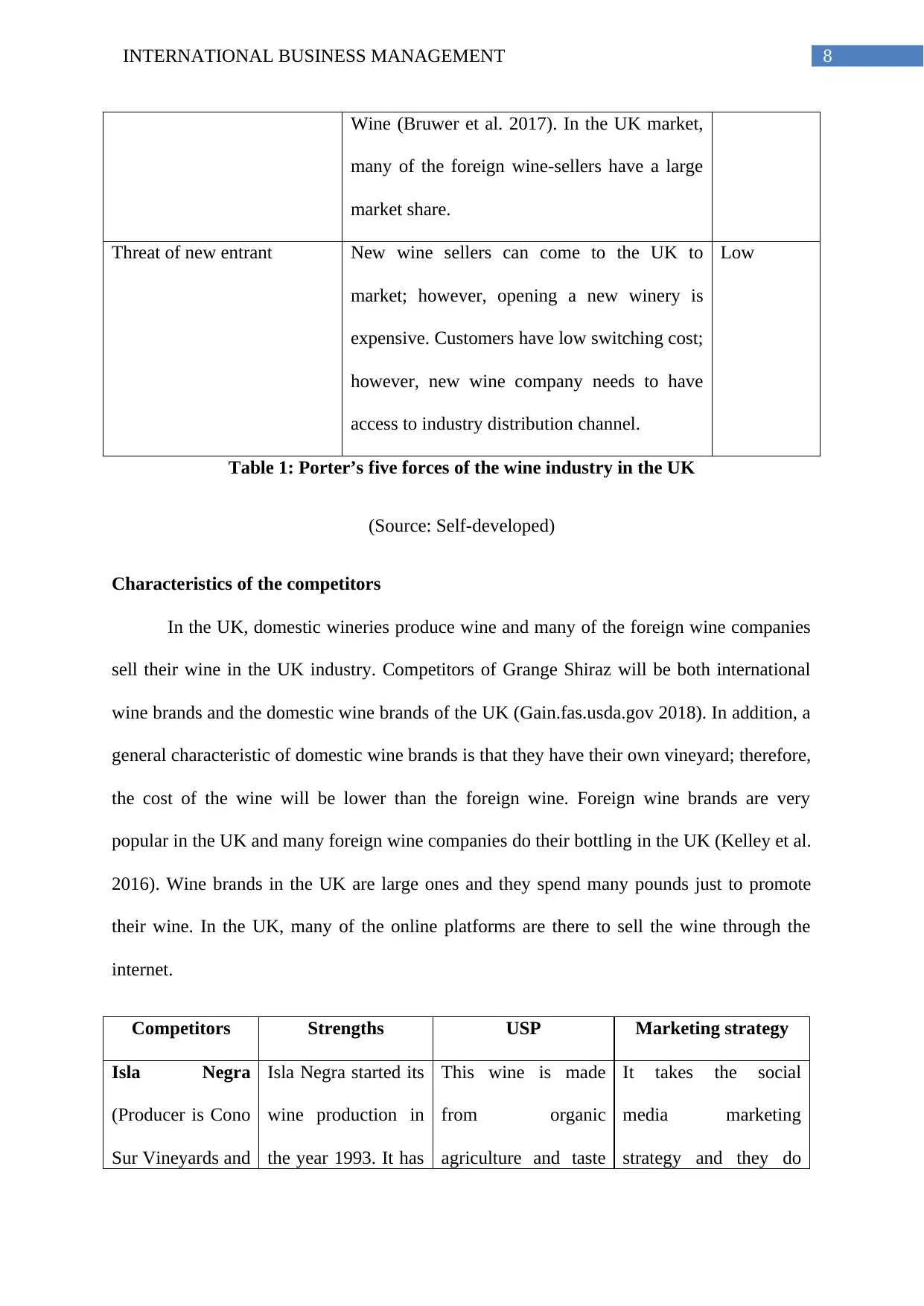
8INTERNATIONAL BUSINESS MANAGEMENT
Wine (Bruwer et al. 2017). In the UK market,
many of the foreign wine-sellers have a large
market share.
Threat of new entrant New wine sellers can come to the UK to
market; however, opening a new winery is
expensive. Customers have low switching cost;
however, new wine company needs to have
access to industry distribution channel.
Low
Table 1: Porter’s five forces of the wine industry in the UK
(Source: Self-developed)
Characteristics of the competitors
In the UK, domestic wineries produce wine and many of the foreign wine companies
sell their wine in the UK industry. Competitors of Grange Shiraz will be both international
wine brands and the domestic wine brands of the UK (Gain.fas.usda.gov 2018). In addition, a
general characteristic of domestic wine brands is that they have their own vineyard; therefore,
the cost of the wine will be lower than the foreign wine. Foreign wine brands are very
popular in the UK and many foreign wine companies do their bottling in the UK (Kelley et al.
2016). Wine brands in the UK are large ones and they spend many pounds just to promote
their wine. In the UK, many of the online platforms are there to sell the wine through the
internet.
Competitors Strengths USP Marketing strategy
Isla Negra
(Producer is Cono
Sur Vineyards and
Isla Negra started its
wine production in
the year 1993. It has
This wine is made
from organic
agriculture and taste
It takes the social
media marketing
strategy and they do
Wine (Bruwer et al. 2017). In the UK market,
many of the foreign wine-sellers have a large
market share.
Threat of new entrant New wine sellers can come to the UK to
market; however, opening a new winery is
expensive. Customers have low switching cost;
however, new wine company needs to have
access to industry distribution channel.
Low
Table 1: Porter’s five forces of the wine industry in the UK
(Source: Self-developed)
Characteristics of the competitors
In the UK, domestic wineries produce wine and many of the foreign wine companies
sell their wine in the UK industry. Competitors of Grange Shiraz will be both international
wine brands and the domestic wine brands of the UK (Gain.fas.usda.gov 2018). In addition, a
general characteristic of domestic wine brands is that they have their own vineyard; therefore,
the cost of the wine will be lower than the foreign wine. Foreign wine brands are very
popular in the UK and many foreign wine companies do their bottling in the UK (Kelley et al.
2016). Wine brands in the UK are large ones and they spend many pounds just to promote
their wine. In the UK, many of the online platforms are there to sell the wine through the
internet.
Competitors Strengths USP Marketing strategy
Isla Negra
(Producer is Cono
Sur Vineyards and
Isla Negra started its
wine production in
the year 1993. It has
This wine is made
from organic
agriculture and taste
It takes the social
media marketing
strategy and they do
⊘ This is a preview!⊘
Do you want full access?
Subscribe today to unlock all pages.

Trusted by 1+ million students worldwide
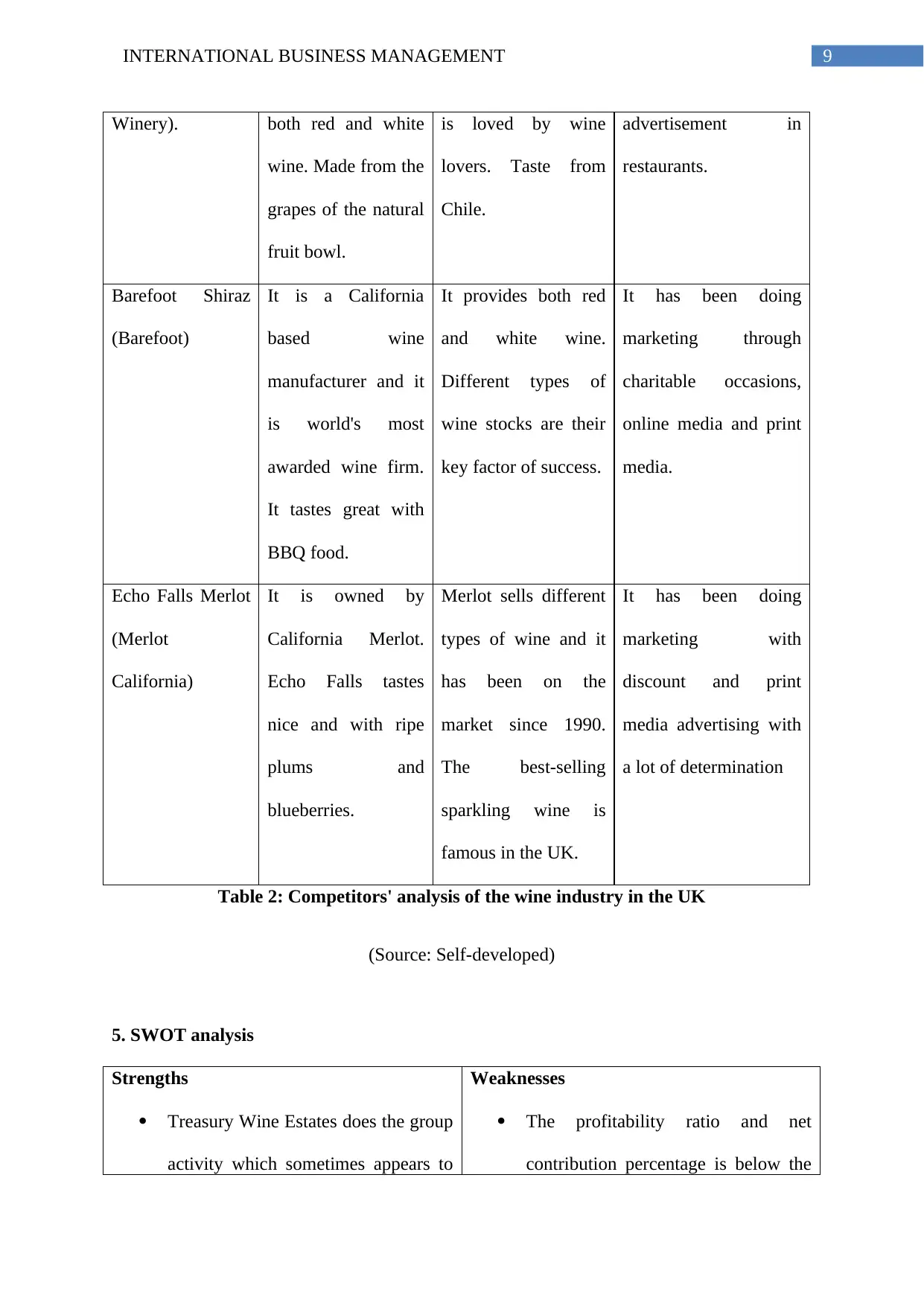
9INTERNATIONAL BUSINESS MANAGEMENT
Winery). both red and white
wine. Made from the
grapes of the natural
fruit bowl.
is loved by wine
lovers. Taste from
Chile.
advertisement in
restaurants.
Barefoot Shiraz
(Barefoot)
It is a California
based wine
manufacturer and it
is world's most
awarded wine firm.
It tastes great with
BBQ food.
It provides both red
and white wine.
Different types of
wine stocks are their
key factor of success.
It has been doing
marketing through
charitable occasions,
online media and print
media.
Echo Falls Merlot
(Merlot
California)
It is owned by
California Merlot.
Echo Falls tastes
nice and with ripe
plums and
blueberries.
Merlot sells different
types of wine and it
has been on the
market since 1990.
The best-selling
sparkling wine is
famous in the UK.
It has been doing
marketing with
discount and print
media advertising with
a lot of determination
Table 2: Competitors' analysis of the wine industry in the UK
(Source: Self-developed)
5. SWOT analysis
Strengths
Treasury Wine Estates does the group
activity which sometimes appears to
Weaknesses
The profitability ratio and net
contribution percentage is below the
Winery). both red and white
wine. Made from the
grapes of the natural
fruit bowl.
is loved by wine
lovers. Taste from
Chile.
advertisement in
restaurants.
Barefoot Shiraz
(Barefoot)
It is a California
based wine
manufacturer and it
is world's most
awarded wine firm.
It tastes great with
BBQ food.
It provides both red
and white wine.
Different types of
wine stocks are their
key factor of success.
It has been doing
marketing through
charitable occasions,
online media and print
media.
Echo Falls Merlot
(Merlot
California)
It is owned by
California Merlot.
Echo Falls tastes
nice and with ripe
plums and
blueberries.
Merlot sells different
types of wine and it
has been on the
market since 1990.
The best-selling
sparkling wine is
famous in the UK.
It has been doing
marketing with
discount and print
media advertising with
a lot of determination
Table 2: Competitors' analysis of the wine industry in the UK
(Source: Self-developed)
5. SWOT analysis
Strengths
Treasury Wine Estates does the group
activity which sometimes appears to
Weaknesses
The profitability ratio and net
contribution percentage is below the
Paraphrase This Document
Need a fresh take? Get an instant paraphrase of this document with our AI Paraphraser
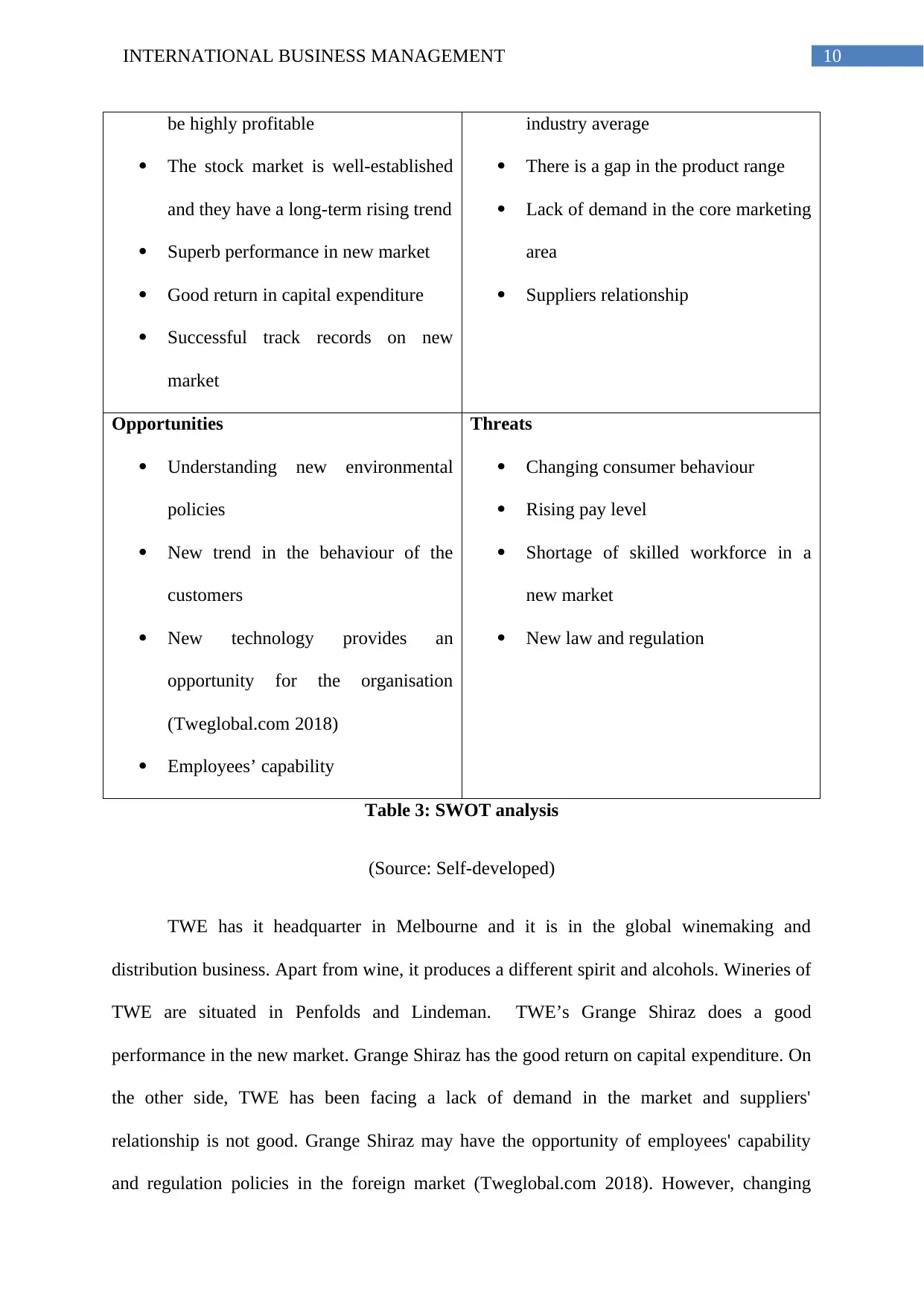
10INTERNATIONAL BUSINESS MANAGEMENT
be highly profitable
The stock market is well-established
and they have a long-term rising trend
Superb performance in new market
Good return in capital expenditure
Successful track records on new
market
industry average
There is a gap in the product range
Lack of demand in the core marketing
area
Suppliers relationship
Opportunities
Understanding new environmental
policies
New trend in the behaviour of the
customers
New technology provides an
opportunity for the organisation
(Tweglobal.com 2018)
Employees’ capability
Threats
Changing consumer behaviour
Rising pay level
Shortage of skilled workforce in a
new market
New law and regulation
Table 3: SWOT analysis
(Source: Self-developed)
TWE has it headquarter in Melbourne and it is in the global winemaking and
distribution business. Apart from wine, it produces a different spirit and alcohols. Wineries of
TWE are situated in Penfolds and Lindeman. TWE’s Grange Shiraz does a good
performance in the new market. Grange Shiraz has the good return on capital expenditure. On
the other side, TWE has been facing a lack of demand in the market and suppliers'
relationship is not good. Grange Shiraz may have the opportunity of employees' capability
and regulation policies in the foreign market (Tweglobal.com 2018). However, changing
be highly profitable
The stock market is well-established
and they have a long-term rising trend
Superb performance in new market
Good return in capital expenditure
Successful track records on new
market
industry average
There is a gap in the product range
Lack of demand in the core marketing
area
Suppliers relationship
Opportunities
Understanding new environmental
policies
New trend in the behaviour of the
customers
New technology provides an
opportunity for the organisation
(Tweglobal.com 2018)
Employees’ capability
Threats
Changing consumer behaviour
Rising pay level
Shortage of skilled workforce in a
new market
New law and regulation
Table 3: SWOT analysis
(Source: Self-developed)
TWE has it headquarter in Melbourne and it is in the global winemaking and
distribution business. Apart from wine, it produces a different spirit and alcohols. Wineries of
TWE are situated in Penfolds and Lindeman. TWE’s Grange Shiraz does a good
performance in the new market. Grange Shiraz has the good return on capital expenditure. On
the other side, TWE has been facing a lack of demand in the market and suppliers'
relationship is not good. Grange Shiraz may have the opportunity of employees' capability
and regulation policies in the foreign market (Tweglobal.com 2018). However, changing
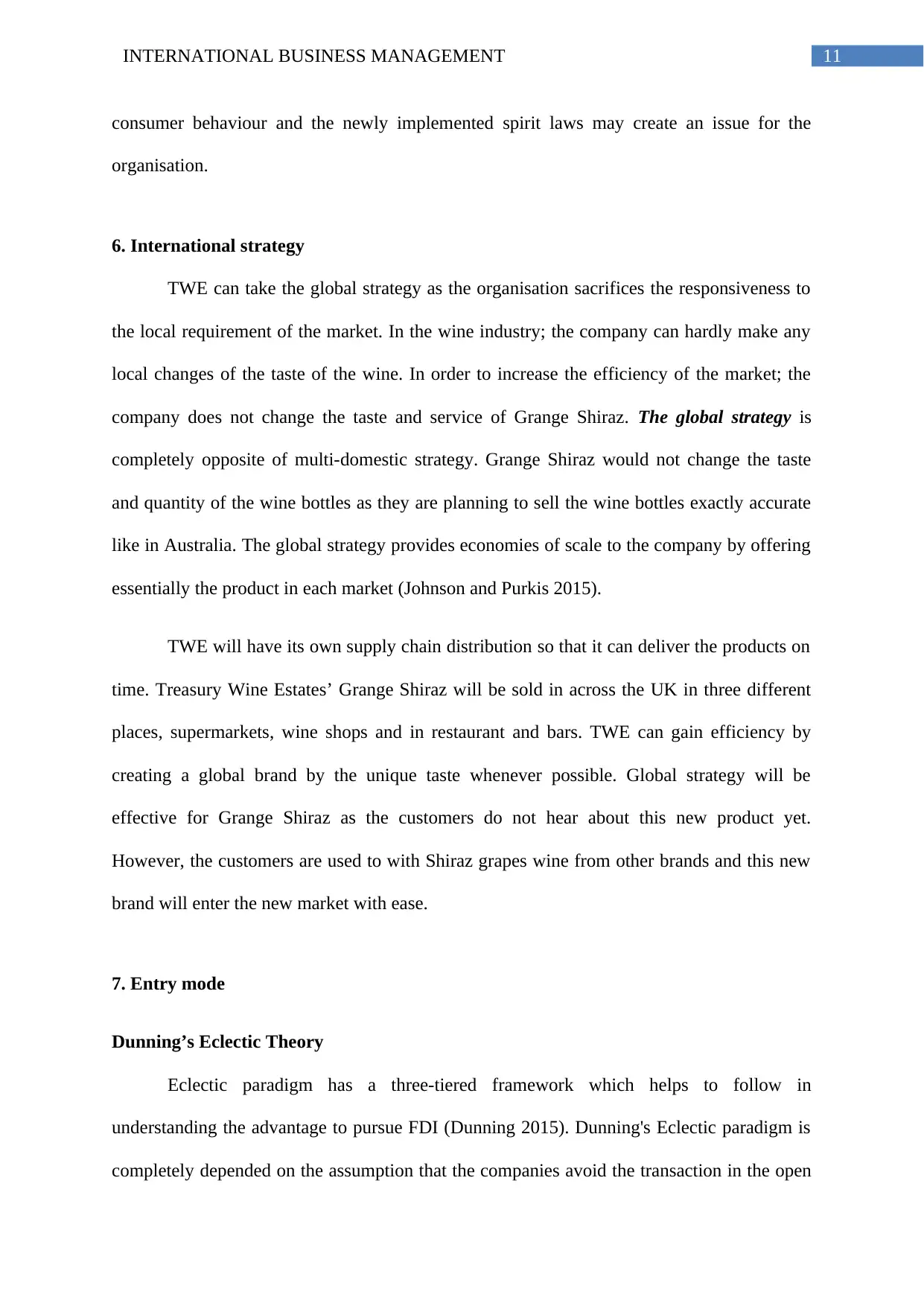
11INTERNATIONAL BUSINESS MANAGEMENT
consumer behaviour and the newly implemented spirit laws may create an issue for the
organisation.
6. International strategy
TWE can take the global strategy as the organisation sacrifices the responsiveness to
the local requirement of the market. In the wine industry; the company can hardly make any
local changes of the taste of the wine. In order to increase the efficiency of the market; the
company does not change the taste and service of Grange Shiraz. The global strategy is
completely opposite of multi-domestic strategy. Grange Shiraz would not change the taste
and quantity of the wine bottles as they are planning to sell the wine bottles exactly accurate
like in Australia. The global strategy provides economies of scale to the company by offering
essentially the product in each market (Johnson and Purkis 2015).
TWE will have its own supply chain distribution so that it can deliver the products on
time. Treasury Wine Estates’ Grange Shiraz will be sold in across the UK in three different
places, supermarkets, wine shops and in restaurant and bars. TWE can gain efficiency by
creating a global brand by the unique taste whenever possible. Global strategy will be
effective for Grange Shiraz as the customers do not hear about this new product yet.
However, the customers are used to with Shiraz grapes wine from other brands and this new
brand will enter the new market with ease.
7. Entry mode
Dunning’s Eclectic Theory
Eclectic paradigm has a three-tiered framework which helps to follow in
understanding the advantage to pursue FDI (Dunning 2015). Dunning's Eclectic paradigm is
completely depended on the assumption that the companies avoid the transaction in the open
consumer behaviour and the newly implemented spirit laws may create an issue for the
organisation.
6. International strategy
TWE can take the global strategy as the organisation sacrifices the responsiveness to
the local requirement of the market. In the wine industry; the company can hardly make any
local changes of the taste of the wine. In order to increase the efficiency of the market; the
company does not change the taste and service of Grange Shiraz. The global strategy is
completely opposite of multi-domestic strategy. Grange Shiraz would not change the taste
and quantity of the wine bottles as they are planning to sell the wine bottles exactly accurate
like in Australia. The global strategy provides economies of scale to the company by offering
essentially the product in each market (Johnson and Purkis 2015).
TWE will have its own supply chain distribution so that it can deliver the products on
time. Treasury Wine Estates’ Grange Shiraz will be sold in across the UK in three different
places, supermarkets, wine shops and in restaurant and bars. TWE can gain efficiency by
creating a global brand by the unique taste whenever possible. Global strategy will be
effective for Grange Shiraz as the customers do not hear about this new product yet.
However, the customers are used to with Shiraz grapes wine from other brands and this new
brand will enter the new market with ease.
7. Entry mode
Dunning’s Eclectic Theory
Eclectic paradigm has a three-tiered framework which helps to follow in
understanding the advantage to pursue FDI (Dunning 2015). Dunning's Eclectic paradigm is
completely depended on the assumption that the companies avoid the transaction in the open
⊘ This is a preview!⊘
Do you want full access?
Subscribe today to unlock all pages.

Trusted by 1+ million students worldwide
1 out of 23
Related Documents
Your All-in-One AI-Powered Toolkit for Academic Success.
+13062052269
info@desklib.com
Available 24*7 on WhatsApp / Email
![[object Object]](/_next/static/media/star-bottom.7253800d.svg)
Unlock your academic potential
Copyright © 2020–2025 A2Z Services. All Rights Reserved. Developed and managed by ZUCOL.





